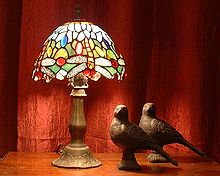Light fixture

A light fixture is an electrical device used to create artificial light or illumination. A luminaire is a lighting fixture complete with the light source or lamp, the reflector for directing the light, an aperture (with or without a lens), the outer shell or housing for lamp alignment and protection, an electrical ballast, if required, and connection to a power source[1]. A wide variety of special light fixtures are created for use in the automotive industry, aerospace, marine and medicine.
Light fixtures are classified by how the fixture is installed, the light function or lamp type.
Light fixture is US usage, in English it is called a light fitting, however Luminaire is the international IEC terminology for technical use.
Fixture types
Free-standing or portable

- Table lamps, standard lamps and office task lights. Note: The use of lamp to describe light fixtures is different from its use to describe electrical components.
- Balanced arm lamp is a spot light with an adjustable arm such as anglepoise or Luxo L1.
- Nightlight
Fixed
- Recessed light—the protective housing is concealed behind a ceiling or wall, leaving only the fixture itself exposed. The ceiling-mounted version is often called a downlight.
- Cans with a variety of lamps—this term is jargon for inexpensive downlighting products that are recessed into the ceiling. The name comes from the shape of the housing. The term pot lights is often used in Canada and parts of the US.
- Troffer light—recessed fluorescent lights (the word comes from the combination of trough and coffer).
- Cove light—recessed into the ceiling in a long box against a wall.
- Torch lamp, torchière, or floor lamp.

- Surface-mounted light—the finished housing is exposed, not flush with surface.
- Chandelier.
- Pendant light—suspended from the ceiling with a chain or pipe.
- Sconce—provide up or down lights; can be used to illuminate artwork, architectural details; commonly used in hallways and/or as an alternative to overhead lighting.
- Track lighting fixture—individual fixtures (track heads) can be positioned anywhere along the track, which provides electric power.
- Under-cabinet light—mounted below kitchen wall cabinets..
- Emergency lighting or exit light—connected to a battery or to an electric circuit that has backup power if the main power fails.
- High bay/low bay lighting—typically used for general lighting for industrial buildings.
- Strip lights or industrial lights—often long lines of fluorescent lamps used in a warehouse or factory.

- Outdoor lighting—used to illuminate walkways, parking lots, roadways, building exteriors, landscape, and architectural details.
- Pole or stanchion mounted—for landscape, roadways, and parking lots.
- Pathway lighting—typically mounted in the ground at low levels for illuminating walkways.
- Bollards—A type of architectural outdoor lighting that is a short, upright ground-mounted unit typically used to provide cutoff type illumination for egress lighting, to light walkways, steps, or other pathways.
- Street light.
- Yard light.
- Solar lamp.
Special purpose lights
- Accent light
- Background light (for use in film and television production)
- Blacklight
- Flood light
- Safelight (for use in a dark room)
- Safety lamp (for use in coal mines)
- Searchlight (for military and advertising use)
- Security lighting
- Step light
- Strobe light
- Followspot (for use in a theatre)
- Wallwasher
Lamp types

- Fuel lamps
- Betty lamp, butter lamp, carbide lamp, gas lighting, kerosene lamp, oil lamp, rush light, torch, candle, Limelight, gas mantle
- Safety lamps: Davy lamp & Geordie lamp
- A-lamp, PAR Parabolic reflector lamp (PAR), Reflector lamp (R), Bulged reflector lamp (BR) (Refer to lamp bases)
- Obsolete types: Limelight, Carbon button lamp, Mazda (light bulb), Nernst glower
- Novelty: Lava lamp
- Special purpose: Heat lamp, Globar, gas mantle
- Halogen – special class of incandescent lamps
- Gas discharge lamp and High-Intensity Discharge lamp (HID)
- Mercury-vapor lamp, Metal-halide (HMI, HQI, CDM), Sodium vapor or "high pressure sodium"
- Plasma lamp
- Fluorescent
- Cold cathode
- Fiber optics
- Induction lamp
- Light-Emitting Diode (LED) (Solid state lighting)
- Nuclear: Self-powered lighting
Light fixture controls
See also
- Architectural lighting design
- Coefficient of utilization
- History of street lighting in the United States
- Lighting designer for the theater
- List of light sources
- Luminous efficacy
- Timeline of lighting technology
References
External links
Floor Lamp Provides quality information on floor lamps.
- Look at the Chart and Pick Out the Reflector You Need, Popular Science monthly, February 1919, page 75, Scanned by Google Books: http://books.google.com/books?id=7igDAAAAMBAJ&pg=PA75
